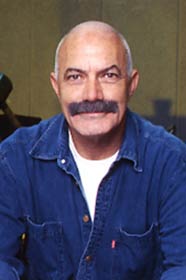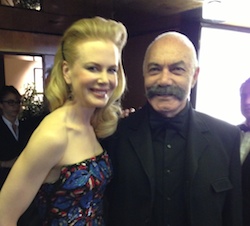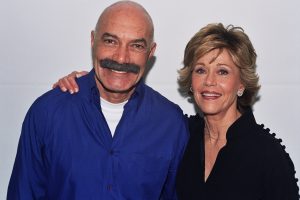Roberto Rossellini’s personal favorite film, Flowers of St. Francis was co-written with Federico Fellini, beginning with a treatment of 28 pages, which contained only 71 lines of dialogue.
The film is based on two books, the 14th-century novel Fioretti di San Francesco (Little Flowers of St. Francis) and La Vita di Frate Ginepro (The Life of Brother Juniper), about the life and work of St. Francis and the early Franciscans.
The novel is less biographical and instead focuses on tales of the life of St. Francis and his followers. Rather than relating all 78 chapters of the book, the film centers on nine of them, each containing a moral theme.
Every new scene transitions with a chapter marker, a device that directly relates to the novel.
On October 6, 1952, when the movie debuted in America, where the novel was less known, the chapter markers were removed.
Gianfranco Bellini as the narrator has voice-dubbed several American films for the Italian cinema.
Monks from the Nocere Inferiore Monastery played the roles of St. Francis and the friars. Playing the role of St. Francis is a Franciscan brother who is not credited, Brother Nazario Gerardi.
The film’s only professional actor, Aldo Fabrizi, had worked with Rossellini before in Rome, Open City. Fabrizi began his film career scene in 1942 and is noted for both writing and directing his own vehicles. In this film, Fabrizi plays the role of Nicolaio, the tyrant of Viterbo.
Though not a practicing Catholic, Rossellini loved the Church’s ethical teaching and was enchanted by religious sentiment, which inspired the making of the film. He also employed two priests to work on it with him, Félix A. Morlion O.P., and Antonio Lisandri O.F.M., whose presence gave the film respectability.
Narrative Structure: Chapters
The movie begins by portraying the Franciscan friars trudging through the rain to their hut, now occupied by a peasant and his donkey. The man accuses the Franciscans of being thieves and drives them out, but the friars see this as a sign to follow the footsteps of St. Francis.
The film is divided into 9 chapters, each depicting a significant incident in St. Francis’ life, and introduced by a parable and a chapter marker.
In the first chapter, Brother Ginepro returns to St. Mary of the Angels naked after giving away his habit to a beggar. St. Francis gently admonishes him for his naive generosity.
Chapter 2 focuses on Giovanni, known as “the Simpleton,” who asks to follow Francis and begins imitating him in word and gesture. Despite some obstacles, Giovanni is welcomed as a fellow Franciscan.
Chapter 3 portrays the wonderful meeting between St. Clare and St. Francis at St. Mary of the Angels. They share a holy dinner together, and their conversation is described as igniting the sky with fire.
Chapter 4: Brother Ginepro cuts off a pig’s foot to make a stew for a sick brother. However, he unwittingly angers a peasant and must apologize. The peasant later returns with the rest of the pig as a gesture of reconciliation.
Chapter 5 depicts Francis praying in the woods when he encounters a leper. Despite the leper’s attempts to keep his distance, Francis kisses and adores him, praising God for the encounter.
Chapter 7: Brother Ginepro cooks enough food for two weeks, impressing Francis with his zeal. As a result, Francis grants Ginepro permission to preach, instructing him to begin each sermon with the words, “I talk and talk yet I accomplish little.”
Chapter 7 focuses on Brother Ginepro as he travels and attempts to preach. He is judged on the gallows by the tyrant Nicolaio but demonstrates humility that eventually convinces Nicolaio to spare him.
Chapter 8 presents a famous parable where Francis and Brother Leone discuss what brings perfect happiness. After considering various scenarios, Francis explains that perfect happiness lies in suffering and bearing every evil deed out of love for Christ.
In the final chapter, Francis and his friars leave St. Mary of the Angels to spread the Gospel. They give away their possessions, pray together, and then set off in different directions.
The movie was not intended to be a biopic, but rather a portrait of some specific aspects of St. Francis’s personality, like his whimsy nature as “The Jester of God.”
Rossellini received funding from Angelo Rizzoli and from the Vatican to make the film. He cast the same Franciscan monks who had appeared in his earlier film Paisà.
During the shooting Rossellini’s and Ingrid Bergman’s son Renato was born, February 2, 1950, although he was not officially divorced until February 9.
The film premiered at the 1950 Venice Film Fest to critical acclaim, where the audience often applauded in the middle of certain scenes. However, critics gave the film mostly poor reviews. On its initial release, the movie earned less than $13,000 in Italy.
Pasolini and Truffaut said that it was “among the most beautiful works in Italian cinema
Now recognized as a classic of world cinema, the film has been released on DVD by The Criterion Collection. In 1995, the Vatican included the film in its list of 45 important films.
Cast
Brother Nazario Gerardi as Saint Francis of Assisi
Brother Severino Pisacane as Brother Ginepro
Esposito Bonaventura as Giovanni
Aldo Fabrizi as Nicolaio, the tyrant
Arabella Lemaître as Saint Clare of Assisi
Brother Nazareno, Brother Raffaele and Brother Robert Sorrentino as Franciscans










